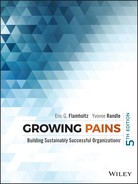Part III
Special Aspects of Organizational Transitions in Growing and Changing Enterprises
The previous sections of this book have examined the organizational issues and related managerial tools required by organizations to become sustainably successful at different stages of growth. This section of the book deals with some special issues related to these transitions.
Throughout the book, we have provided brief examples of how our concepts can be applied to nonprofits. The purpose of Chapter 11 is to provide a more comprehensive description of how the concepts, frameworks, and tools presented in this book can be used by a nonprofit to manage growing pains and build a sustainably successful enterprise. The chapter will also explore and provide suggestions for effectively managing some of the unique aspects of nonprofits—including the relationship between staff and volunteer boards. We will use case studies from actual organizations—some will be disguised—to illustrate how the concepts in this book can be effectively used by a nonprofit's leadership team to promote success.
As leadership is an important ingredient in long-term success, Chapter 12 focuses on this topic. This chapter defines leadership and describes the two types of leadership that need to be present within a successful organization—operational (day-to-day) and strategic. It then identifies the key tasks of operational and strategic leadership (what effective leaders do) and also describes how to choose a leadership style that will help influence people to achieve organizational goals. Finally, it introduces the concept of a “leadership molecule”—a true leadership team that performs the tasks of strategic leadership needed to support the organization's development and long-term success.
Chapter 13 describes the experiences of actual companies that have applied the concepts, frameworks, methods, and tools described throughout this book. Its purpose is to share insights with you that will facilitate the application of the intellectual content presented in this book to your own organization. We will describe what was done and, to the extent possible, the results. The chapter focuses primarily upon companies from Stages III to VI because that is primarily where the concepts, frameworks, methods, and tools presented in this book have the greatest impact, and those companies have been our focus in our consulting applications. In these examples, we will (to the extent feasible) discuss the issues faced at various stages of growth in each company's life cycle.
